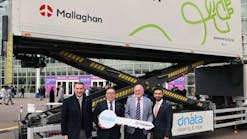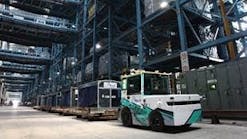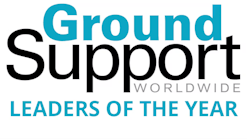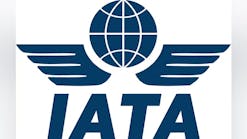The global Air Cargo Security Screening market is currently valued at approximately $4.8 billion in 2024 and is projected to reach around $8.2 billion by 2034, according to research by Exactitude Consultancy.
This growth reflects a steady Compound Annual Growth Rate (CAGR) of 5.6% during the forecast period from 2025 to 2034. The expansion of global air freight, driven by the surge in e-commerce and the continuous rise in international trade activities, is amplifying the demand for sophisticated security screening solutions.
According to the study released on Feb. 10, The industry is witnessing a significant transition toward automation, with artificial intelligence and machine learning-powered systems playing a pivotal role in enhancing screening accuracy and operational efficiency. However, the market faces persistent challenges such as regional disparities in regulatory frameworks and the substantial costs associated with deploying advanced security technologies.
Despite these hurdles, there is immense potential in developing innovative screening methodologies that align with emerging regulatory mandates while addressing the increasing demand for secure and seamless supply chain solutions.
Additionally, sustainability concerns are shaping technological advancements, prompting market players to integrate eco-friendly solutions into security infrastructure. Collaborations and strategic partnerships among technology providers, logistics firms, and regulatory bodies are further driving market expansion, ensuring that the sector remains on an upward trajectory with a strong emphasis on security and efficiency in air cargo logistics.
Market growth drivers
Several key factors are fueling the expansion of the Air Cargo Security Screening market, the study says, reinforcing the necessity of robust security measures in the aviation industry.
- Surging Air Freight Volumes: The International Air Transport Association (IATA) forecasts that global air cargo revenue will exceed $169 billion by 2026. This rapid increase in freight movement necessitates advanced screening solutions to enhance cargo handling capabilities while ensuring security and compliance with regulatory standards.
- Stringent Regulatory Compliance: Global aviation security is governed by stringent regulations enforced by authorities such as the Transportation Security Administration (TSA) and the European Union Aviation Safety Agency (EASA). These bodies mandate comprehensive screening protocols, compelling logistics firms to invest in high-tech security solutions to avoid penalties and streamline cargo processing.
- Technological Advancements in Screening: The deployment of cutting-edge screening technologies, including computed tomography (CT) scanners, automated threat detection systems, and multi-view X-ray machines, is transforming security protocols. These advancements facilitate faster and more precise screening, reducing false alarms and expediting the clearance of shipments.
- Rising Global Security Threats: The increasing risk of terrorism, smuggling, and illicit trade has heightened the focus on cargo security. High-profile incidents, such as the 2010 cargo bomb plot, underscore the critical need for enhanced threat detection mechanisms, prompting investments in advanced screening infrastructure.
- E-commerce and Logistics Expansion: The post-pandemic e-commerce boom has accelerated the demand for faster and more secure shipping solutions. This shift is driving greater investment in air cargo security to accommodate high shipment volumes while mitigating risks associated with cross-border trade.
Market challenges and restraints
While the Air Cargo Security Screening market presents vast growth opportunities, certain challenges could hinder its expansion.
- High Capital Investment Requirements: The deployment of sophisticated screening solutions entails significant initial costs, including procurement, installation, and maintenance. Small and medium-sized logistics firms may struggle to allocate the necessary funds, restricting the adoption of advanced security measures.
- Diverse and Complex Regulatory Environment: Air cargo security regulations vary across countries and regions, creating compliance difficulties for global logistics operators. Adapting to these ever-evolving standards demands continuous monitoring and investment, which can pose operational challenges.
- Technology-Related Limitations: Despite major advancements, existing security systems still experience inefficiencies, such as false positives and negatives, causing logistical delays and added costs due to re-screening procedures. Continuous upgrades and workforce training remain essential to addressing these limitations.
- Shortage of Skilled Workforce: Operating sophisticated security screening equipment requires specialized training and expertise. The ongoing shortage of trained personnel in the logistics sector poses a challenge to maintaining seamless and effective security operations.
- Resistance to New Technologies: The adoption of modern security infrastructure is sometimes hindered by the reluctance of industry players to replace legacy systems. This inertia slows down the integration of innovative security solutions and limits the efficiency gains achievable through automation.
Emerging market opportunities
The evolving landscape of the Air Cargo Security Screening market presents multiple opportunities that can accelerate growth and innovation.
- Integration of AI and Big Data Analytics: AI-powered security screening solutions are revolutionizing threat detection through real-time data processing and pattern recognition. These technologies significantly enhance the speed, accuracy, and adaptability of security checks, reducing human intervention while improving efficiency.
- Growth of Screening-as-a-Service (ScaaS): ScaaS models are gaining traction, allowing logistics firms to leverage high-end security infrastructure without the burden of heavy upfront investments. This service-based approach ensures that even smaller logistics players can access advanced screening technologies while complying with security regulations.
- Collaborations in Security Solutions: Stronger partnerships between technology developers, logistics firms, and regulatory bodies can lead to more comprehensive security frameworks. Joint initiatives focused on data-sharing and real-time monitoring systems can enhance security outcomes while streamlining regulatory compliance.
- Sustainability-Focused Innovation: The emphasis on eco-friendly operations in the aviation industry is influencing the development of energy-efficient screening systems. Sustainable security solutions that minimize energy consumption and electronic waste are gaining traction, attracting investments from environmentally-conscious stakeholders.
- Expanding Market Presence in Emerging Economies: The rising air freight activity in developing regions such as Asia-Pacific and Latin America presents significant opportunities for security solution providers. Governments and industry leaders are prioritizing the modernization of cargo security systems, creating a fertile ground for market expansion.
Regional market trends and analysis
The global Air Cargo Security Screening market demonstrates varied growth dynamics across different geographical regions.
- North America: This region commands the largest market share, contributing approximately 45% of the total revenue in 2024. The presence of stringent regulatory policies, coupled with advanced technological infrastructure, has cemented North America's dominance in air cargo security.
- Europe: Accounting for around 30% of the market in 2024, Europe is a key player, driven by strict EU regulations and a well-established trade network. With a projected CAGR of 4.5% through 2034, the region is experiencing significant investments in security technology enhancements.
- Asia-Pacific: Rapid economic growth, increasing e-commerce transactions, and expanding logistics networks position Asia-Pacific as a high-growth region, expected to reach a market share of 20% in 2024 with a CAGR of 5.5%.
- Latin America and Middle East & Africa: These regions, while smaller in market size, present growth potential due to evolving regulatory policies and increasing cross-border trade activities. Latin America is forecasted to grow at a CAGR of 3.8%, while the Middle East & Africa market is anticipated to expand at 4.2% CAGR.
Key trends driving the air cargo security screening market
The market is shaped by several pivotal factors, including regulatory enforcement, technological breakthroughs, and evolving security concerns.
- Stringent Regulations: Governments and aviation authorities worldwide continue to impose stricter security requirements, compelling market players to innovate and enhance compliance measures.
- Growing Threat Landscape: Rising instances of smuggling, terrorism, and illegal cargo activities necessitate advanced detection systems that can quickly and accurately identify threats.
- Technological Evolution: AI-driven imaging, real-time data analytics, and machine learning integration are revolutionizing cargo screening, significantly improving detection accuracy and operational efficiency.
Future market growth potential (2025-2034)
The air cargo security screening market is poised for substantial expansion over the next decade, driven by increasing global trade, regulatory mandates, and advancements in security technology. The following areas highlight the market’s high-growth potential:
- Advancements in X-ray and CT Technologies: Continuous innovations are expected to redefine traditional screening methods, leading to wider adoption and market expansion.
- Investment in AI-Enabled Solutions: The integration of artificial intelligence into screening technologies will enhance detection capabilities and improve processing efficiency.
- Integration with IT Infrastructure: The use of data analytics, cloud computing, and real-time monitoring will further optimize cargo security screening systems, streamlining air freight operations.
Market drivers fueling industry growth
- Rising Demand for Secure Cargo Transportation: With increasing globalization and cross-border trade, air cargo volumes are surging. As a result, security screening solutions are becoming more critical than ever.
- Advancements in Screening Technologies: Cutting-edge innovations, including automated threat detection and enhanced imaging solutions, are improving screening accuracy while reducing delays.
- Regulatory Compliance & Security Standards: Governments and regulatory agencies worldwide are imposing stricter guidelines, prompting investment in modernized screening infrastructure to ensure adherence to security protocols.
- Airport Infrastructure Modernization: The expansion of aviation facilities and the establishment of dedicated cargo terminals are creating a significant demand for state-of-the-art security screening systems.
The full report can be obtained here.




